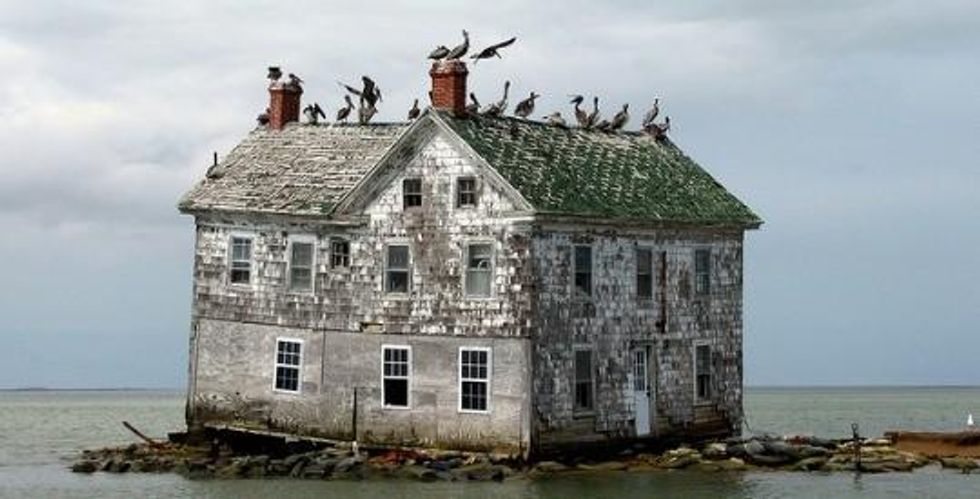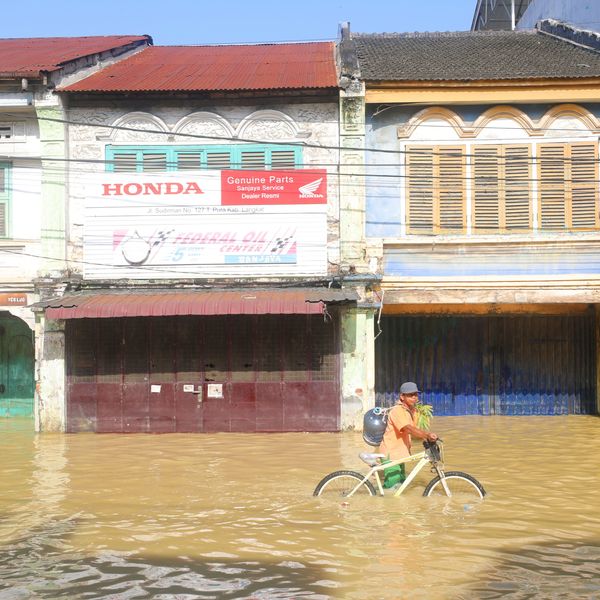Rising Seas, Sinking Coasts Spell Doom for Eastern US
New scientific evidence reveals East Coast as 'global hot spot' for rising sea levels

A new report published Tuesday by the New York Times explains that, as the waters continue to rise, the land along the East Coast is also sinking, spelling disaster for coastal communities.
Accumulating scientific evidence suggests that the East Coast "will be a global hot spot for a rising sea level over the coming century," notes New York Times reporter Justin Gillis.
"Scientists say the East Coast will be hit harder for many reasons, but among the most important is that even as the seawater rises, the land in this part of the world is sinking," spelling "enormous risk for the United States," Gillis reports.
Scientists have discovered that an ice sheet, which blanketed the upper half of North America following the last Ice Age, had caused the land along the Eastern Seaboard to buckle and rise. The subsequent melting of that ice is now causing the adjacent land to fall, meeting the rising sea.
The sinking, the New York Times reports, is occurring "all the way from southern Maine to northern Florida," and is most dramatic in the Chesapeake Bay region where whole island communities have already washed out to sea.
Scientists estimate that since 1880, the global average sea level rose a little over eight inches.
However, due to increasingly high levels of carbon pollution in the atmosphere, by 2100 that amount could surge to more than four feet over today's levels which--according to a study published earlier this year--at high tide could "submerge more than half of today's population in 316 coastal cities and towns (home to 3.6 million) in the lower 48 states."
According to the study, the U.S. cities most under threat from future coastal flooding include Miami, Virginia Beach, Va., and Jacksonville, Fla. with Boston and New York City closely following.
_____________________
An Urgent Message From Our Co-Founder
Dear Common Dreams reader, The U.S. is on a fast track to authoritarianism like nothing I've ever seen. Meanwhile, corporate news outlets are utterly capitulating to Trump, twisting their coverage to avoid drawing his ire while lining up to stuff cash in his pockets. That's why I believe that Common Dreams is doing the best and most consequential reporting that we've ever done. Our small but mighty team is a progressive reporting powerhouse, covering the news every day that the corporate media never will. Our mission has always been simple: To inform. To inspire. And to ignite change for the common good. Now here's the key piece that I want all our readers to understand: None of this would be possible without your financial support. That's not just some fundraising cliche. It's the absolute and literal truth. We don't accept corporate advertising and never will. We don't have a paywall because we don't think people should be blocked from critical news based on their ability to pay. Everything we do is funded by the donations of readers like you. Will you donate now to help power the nonprofit, independent reporting of Common Dreams? Thank you for being a vital member of our community. Together, we can keep independent journalism alive when it’s needed most. - Craig Brown, Co-founder |

A new report published Tuesday by the New York Times explains that, as the waters continue to rise, the land along the East Coast is also sinking, spelling disaster for coastal communities.
Accumulating scientific evidence suggests that the East Coast "will be a global hot spot for a rising sea level over the coming century," notes New York Times reporter Justin Gillis.
"Scientists say the East Coast will be hit harder for many reasons, but among the most important is that even as the seawater rises, the land in this part of the world is sinking," spelling "enormous risk for the United States," Gillis reports.
Scientists have discovered that an ice sheet, which blanketed the upper half of North America following the last Ice Age, had caused the land along the Eastern Seaboard to buckle and rise. The subsequent melting of that ice is now causing the adjacent land to fall, meeting the rising sea.
The sinking, the New York Times reports, is occurring "all the way from southern Maine to northern Florida," and is most dramatic in the Chesapeake Bay region where whole island communities have already washed out to sea.
Scientists estimate that since 1880, the global average sea level rose a little over eight inches.
However, due to increasingly high levels of carbon pollution in the atmosphere, by 2100 that amount could surge to more than four feet over today's levels which--according to a study published earlier this year--at high tide could "submerge more than half of today's population in 316 coastal cities and towns (home to 3.6 million) in the lower 48 states."
According to the study, the U.S. cities most under threat from future coastal flooding include Miami, Virginia Beach, Va., and Jacksonville, Fla. with Boston and New York City closely following.
_____________________

A new report published Tuesday by the New York Times explains that, as the waters continue to rise, the land along the East Coast is also sinking, spelling disaster for coastal communities.
Accumulating scientific evidence suggests that the East Coast "will be a global hot spot for a rising sea level over the coming century," notes New York Times reporter Justin Gillis.
"Scientists say the East Coast will be hit harder for many reasons, but among the most important is that even as the seawater rises, the land in this part of the world is sinking," spelling "enormous risk for the United States," Gillis reports.
Scientists have discovered that an ice sheet, which blanketed the upper half of North America following the last Ice Age, had caused the land along the Eastern Seaboard to buckle and rise. The subsequent melting of that ice is now causing the adjacent land to fall, meeting the rising sea.
The sinking, the New York Times reports, is occurring "all the way from southern Maine to northern Florida," and is most dramatic in the Chesapeake Bay region where whole island communities have already washed out to sea.
Scientists estimate that since 1880, the global average sea level rose a little over eight inches.
However, due to increasingly high levels of carbon pollution in the atmosphere, by 2100 that amount could surge to more than four feet over today's levels which--according to a study published earlier this year--at high tide could "submerge more than half of today's population in 316 coastal cities and towns (home to 3.6 million) in the lower 48 states."
According to the study, the U.S. cities most under threat from future coastal flooding include Miami, Virginia Beach, Va., and Jacksonville, Fla. with Boston and New York City closely following.
_____________________

